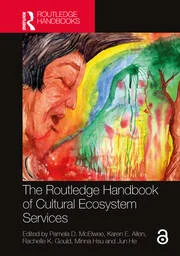Psychological Ecosystem Services
Citation
Bratman, G. N., Garrett, J. K., & Elliott, L. R. Psychological ecosystem services. In The Routledge Handbook of Cultural Ecosystem Services (pp. 43-54). Routledge. doi.org/10.4324/9781003414896-6
Cultural Ecosystem Services (CES) are the nonmaterial benefits people get from nature, like feeling connected to a place, enjoying outdoor activities, learning about culture and history, or having spiritual experiences. These services help support personal and community identity, traditions, and well-being.
Psychological Ecosystem Services (Psych ES) are closely related to CES but focus more specifically on how nature helps our mental and emotional health. This includes things like feeling calmer, happier, or less stressed when spending time in natural places.
While CES and Psych ES often overlap, they come from different research areas and sometimes measure their effects in different ways. This chapter explains how they are similar and different, and how both show the many ways nature supports human well-being.
Abstract
 The nonmaterial benefits of Cultural Ecosystem Services (CES) include categories that are related to personal and community identity, recreation, cultural diversity, heritage, support of knowledge systems, spiritual experiences, and well-being. In many ways, Psychological Ecosystem Services (Psych ES) are a type of CES, though the fields from which this research come differ somewhat with respect to epistemological foundations. Psych ES include the diverse ways in which nature contributes to the mental and emotional well-being of individuals and communities, and encompass the psychological benefits derived from interactions with natural environments. Some CES approaches and outcomes include nonmaterial benefits that are only indirectly related to Psych ES, while others are directly overlapping and use terms that are explicitly included within the scope of Psych ES. A distinction between them lies both in how the outcomes are typically measured and in what the measures and operationalizations of these outcomes are. We discuss these points in detail throughout this chapter.
The nonmaterial benefits of Cultural Ecosystem Services (CES) include categories that are related to personal and community identity, recreation, cultural diversity, heritage, support of knowledge systems, spiritual experiences, and well-being. In many ways, Psychological Ecosystem Services (Psych ES) are a type of CES, though the fields from which this research come differ somewhat with respect to epistemological foundations. Psych ES include the diverse ways in which nature contributes to the mental and emotional well-being of individuals and communities, and encompass the psychological benefits derived from interactions with natural environments. Some CES approaches and outcomes include nonmaterial benefits that are only indirectly related to Psych ES, while others are directly overlapping and use terms that are explicitly included within the scope of Psych ES. A distinction between them lies both in how the outcomes are typically measured and in what the measures and operationalizations of these outcomes are. We discuss these points in detail throughout this chapter.